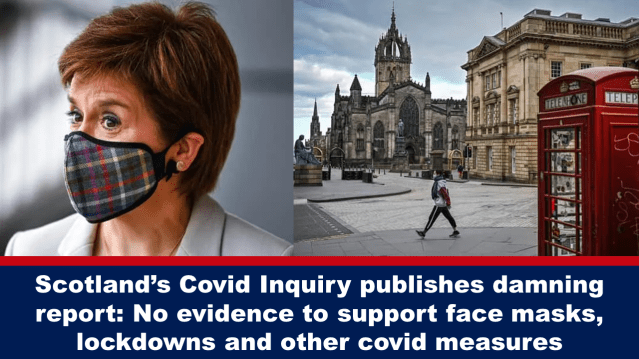Scotland’s Covid Inquiry publishes damning report: No evidence to support face masks, lockdowns and other covid measures
The Scottish Covid-19 Inquiry has published a damning report of the Government’s measures taken in response to covid.
It states that in 2020, there was either insufficient or no evidence to support the use of face masks, lockdowns, social distancing, test, trace and isolation measures in response to the covid pandemic. And, “the evidence base has not changed materially in the intervening three years.”
Let’s not lose touch…Your Government and Big Tech are actively trying to censor the information reported by The Exposé to serve their own needs. Subscribe now to make sure you receive the latest uncensored news in your inbox…
The report was commissioned from an independent expert, Dr Ashley Croft, Consultant Public Health Physician and Medical Epidemiologist. Dr. Croft is an expert in infectious diseases, epidemiology, healthcare-associated infections, travel health, tropical medicine, immunisations and vaccinations. He is a Fellow of the Faculty of Public Health Medicine of the Royal College of Physicians of London and has acted as an invited expert adviser in Parliamentary inquiries.
The 127-page report titled ‘Report for the Scottish Covid-19 Inquiry’ was published on 10 July 2023. You can read it online by clicking on the hyperlink for ‘Dr Ashley Croft’s Report on the Epidemiology of COVID-19’ at the bottom of THIS webpage.
In this article, we focus on the “lockdown” measures employed by governments which they claimed helped to “stop the spread” and “save lives.” The report defines the term “lockdown” as:
Appendix 10 on page 118 of the report lists the ‘Timeline of COVID-19 events in Scotland’. It includes the dates of lockdowns in Scotland which may be useful when reading the damning evidence against them:
- 24 March 2020: Start of lockdown in Scotland.
- 29 May 2020: Move to Phase 1 of the route map out of lockdown
- 19 June 2020: Move to Phase 2 of the route map out of lockdown.
- 10 July 2020: Move to Phase 3 of the route map out of lockdown.
- 5 January 2021: Mainland Scotland goes into lockdown.
As the report is in an easy-to-read format and self-explanatory, below we have simply extracted and reproduced, unedited, text we feel is relevant to the shutdown of the economy and the stay-at-home orders, aka lockdowns. The text is the same order that it appears in the report. We have also included the report’s section titles and subtitles under which the text appears for ease of reference. Any emphasis of the text below is our own.
Part Two – The COVID-19 pandemic
On 23rd January 2020, China imposed a strict lockdown of Wuhan and took similar measures in 15 other cities in the subsequent days. The repressive measures taken in China appeared to slow the progression of the epidemic, though they failed to ‘contain’ it.
2.30 How is COVID-19 prevented? (3) Lockdowns
A major strategy for attempting to limit the spread of SARS-CoV-2 was the introduction by some governments, starting with China, of extreme physical distancing measures; these have been termed lockdowns.
Part Three – physical measures taken against COVID-19
3.1.1 Physical measures advised or mandated in March to July 2020
Comment. During March to July 2020 there was limited scientific evidence and in some cases no scientific evidence (e.g. as regards lockdowns) to support the physical measures that were mandated in Scotland against COVID-19. Such evidence as there was (e.g. for mask wearing) mostly came from hospital settings, rather than community settings – and arguably was not applicable to the general, non-hospital population.
Summary – what do we now know?
In 2020 there was scientific evidence to support the use of some of the physical measures (e.g. frequent handwashing, the use of PPE in hospital settings) adopted against COVID-19.
For other measures (e.g. face mask mandates outside of healthcare settings, lockdowns, social distancing, test, trace and isolate measures) there was either insufficient evidence in 2020 to support their use – or alternatively, no evidence; the evidence base has not changed materially in the intervening three years.
Appendix Nine – previous coronavirus epidemics (SARS and MERS)
Comment. The above short summaries [see the report page 113] of the SARS and MERS novel coronavirus epidemics (they were never designated by WHO as pandemics) are taken from a standard textbook for medical students.
This knowledge was readily available, when the COVID-19 pandemic was declared, in March 2020. Like the 2009–2010 swine flu pandemic, the MERS epidemic of 2012 proved to be self-limiting – although sporadic cases do still occur. Arguably, the 2002–2003 SARS epidemic, which was first recognised in China in November 2002 and then spread to 28 other countries (e.g. Vietnam, Singapore, Canada, USA), was also self-limiting, since most countries did not adopt emergency measures against SARS and yet the epidemic died out, by July 2013.
In China, by contrast, a series of repressive and authoritarian measures, including lockdowns (i.e. closure of schools, workplaces and entertainment venues, and government-enforced stay-at-home orders), social distancing (i.e. enforced spatial separation of at least 1 metre between those infected and those non-infected) border closures, and compulsory face mask wearing were mandated by the Communist Party of China. These extreme government-mandated measures were afterwards judged by the Chinese government – but without any scientific evidence to support this judgment – to have resulted in the ‘containment’ of the SARS epidemic.
In respect of SARS, China was the worst-affected country in the world, by a wide margin. Since secondary attack rates of coronavirus infections within households are high, the ‘containment’ measures against SARS that were adopted by the Communist Party of China may have made their SARS experience worse, not better – for example, by creating hundreds of new foci for the ready acquisition of SARS, in people’s homes.
Notwithstanding these uncertainties, the same 2002–2003 package of repressive and authoritarian ‘containment’ measures (and with the additional new measure of population-wide electronic surveillance of citizens’ movements), was adopted by the Communist Party of China in 2019–2020, at the start of the COVID-19 pandemic.
In early 2020, with high COVID-19 case numbers occurring in most countries – including China itself – the Chinese model of coronavirus ‘containment’ was adopted by many other governments, including the UK and the Scottish governments.
In Scotland, two population-wide electronic surveillance schemes on the Chinese model were procured; these were (i) Test and Protect, procured by the Scottish government in May 2020, and (ii) Protect Scotland, procured by the Scottish government in September 2020. In England, the population-wide electronic surveillance scheme procured in 2020 by the then Secretary of State for Health, Matt Hancock, was called Track and Trace. There is no evidence now, and there was no evidence in 2020, that any of these population-wide electronic surveillance schemes were effective in helping prevent the spread of SARS-CoV-2 infection.

This article has been archived for your research. The original version from The Exposé can be found here.



